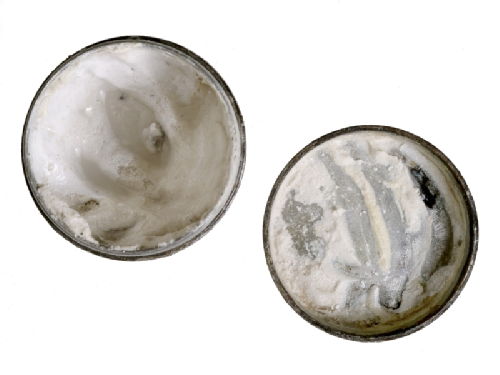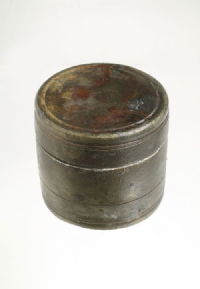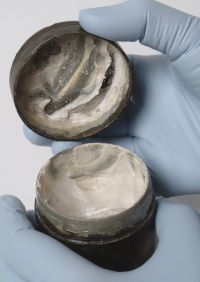All entries for Tuesday 22 June 2021
June 22, 2021
A Roman cosmetic from Southwark
 |
Canister, Museum of London, Object ID LLS02[12855]<3014> Height 53mm, Diameter 58mm. Images reproduced here with the kind permission of the Museum of London. |
In the 21st century, not only is there a vast array of skin-care products and cosmetics on the market, with a huge variety of purposes, ingredients and finishes to choose from, but there are also ethical issues to be considered, such as animal testing and environmental sustainability. A plethora of questions accompany every purchase: peptides, retinol, or collagen? AHAs, Vitamin C or ceramides? Anti-ageing or anti-pollution? Highlight or hide? Hydrate or illuminate? The options are endless.
For the Roman consumer, the choice may have been less daunting, although perhaps fraught with other issues. In 2003, archaeologists were excavating a Roman temple precinct at Tabard Square in Southwark, London, when they made the remarkable discovery of the undecorated tin canister pictured above, which is now on display in the Museum of London. It dates to ca. 150 CE, and given that it was found alongside some intact pottery vessels, and a reasonable quantity and range of other small finds, it has been interpreted as being a ritual, perhaps votive deposit, rather than having been discarded.
 |
 |
Not only is the canister, with its closely fitted lid, a significant find, but its contents, complete with the imprints of fingerprints, are truly extraordinary. It provided a unique opportunity for a team at the University of Bristol to conduct chemical analysis on the soft cream contained inside the canister. This showed that the cream was unperfumed and made from an animal-based fat source (either from sheep or cattle), with added starch (produced from boiling roots or grains in water), and stannic oxide/cassiterite, i.e. tin, which gave a white pigment to the cream. Tin was available in Roman Britain from Cornish tin mines and was used as a substitute for white lead which had commonly been used in Roman cosmetics to whiten the face. The toxicity of white lead had been recognised by the time this cream was produced, and tin may therefore have been a desirable alternative. The University of Bristol team also recreated the cream from their analysis, and although it initially felt greasy when rubbed into the skin, it then left a white powdery smooth texture. There did not appear to be any medicinal value to the cream, and this supports its probable use as being a cosmetic to lighten skin tone.
Another similar, although slightly larger, canister was also found in the excavations at Tabard Square, but it was empty, damaged and missing its lid. However, it is interesting to compare the cream-containing canister with a bronze canister found in Pompeii (Museo Archeologico Nationale di Napoli Inv. No. 5568), which I believe is currently on display in the “Venustas” exhibition in Pompeii (you can see an image of it here: https://www.facebook.com/pompeiisoprintendenza/photos/pcb.2365921063715098/2365918810381990). It came from the House of the Lovers (I, 10, 11), and the shape of the canister and lid appear similar to the Tabard Square container, although this one has further decoration in the form of a small figurine of a child holding grapes and a ball on the lid. The canisters could also have contained other cosmetic preparations such as beautifying masks or treatments, commonly made from honey and vinegar mixed with other organic substances. Additionally, cosmetics based on different pigments were obtained from a wide range of mineral sources, and used as eye shadows, kohl, lip and cheek colours.
However, in antiquity, there was a distinction and indeed tension, between the preservation of beauty via the use of creams and other preparations, which was deemed acceptable, and artificial embellishment, such as via the use of cosmetics, which was considered unacceptable or even immoral (e.g. Galen, De compositione medicamentorum secundum locos 12.434-5, 445-6, 449-50 K.). These ideas are also evident in later Roman moralisation around the use of such cosmetics, with the albeit male dominated sources implying cosmetics were deceptive and suggestive of sexual immorality. Horace creates a vivid mocking image of a woman’s makeup melting in the heat of passion (Epodes 12.10-11); Seneca the Younger praises his mother for not having “defiled” her face with the use of cosmetics (De Consolatione ad Helviam 16.4); whilst Juvenal scorns women beautifying themselves for their lovers (Satire 6.461-470). However, Ovid gives recipes for treatments both to preserve and enhance female beauty in his treatise De Medicamina Faciei and specifically includes the use of “cerussa”, in one of the recipes (Ovid, Medicamina Faciei, 73). Pliny the Elder (Natural History 34.175-180) describes two methods to produce cerussa, which basically involved the combination/dissolving of white lead shavings into vinegar. The resulting substance was then dried out and formed into blocks, giving a fair complexion when applied to the face. Fair skin and a smooth complexion were idealised in the Roman world as being a marker of not just social status, but also of beauty, and sexual attractiveness. There is a variety of evidence which attests to this, for example, Horace describes how Achilles loved Briseis because of her snow-white skin (Ode 2.4); and the later long laudatory epitaph to Allia Potestas contains several references to the fairness and perfection of her skin (CIL 6.37965).
Therefore, although the Roman consumer may not have had so large a variety as the modern day, it would appear that there were certainly a range of different options to maintain, improve or even whiten the skin. Equally, there was certainly a variety of opinion on the use of cosmetic preparations, but unfortunately, we lack any clear female perspective as to their utilisation, which could perhaps balance the social contextualisation. Undoubtedly, the canister from Tabard Square, and more significantly its contents, are such a rare and remarkable find, and one which allowed the chemical analysis to not only replicate its contents, but also authenticate the cream’s effects. Likewise, it demonstrates that attention was being paid to the presumably elite female toilette, even in the remote province of Roman Britain. It may also signify a wider, and potentially influential, geographical spread of the utilisation of cosmetic preparations throughout the Roman empire in the second century AD, probably due to the mobility of merchants as well as spouses and families of the Roman governing elite.
Bibliography:
Evershed, R.P., Berstan, R., Grew, F., Copley, M.S., Charmant, A.J.H., Barham, E., Mottram, H.R. and Brown, G. (2004) “Formulation of a Roman cosmetic” in Nature, Vol. 432 (London, Springer Nature) pp. 35-36.
Johnson, M. (2016) Ovid on Cosmetics: Medicamina faciei femineae and related texts (London, Bloomsbury Academic).
Killock, D., Shepherd, J., Gerrard, J., Hayward, K., Rielly, K. and Ridgeway, V. (2015) Temples and Suburbs, Excavations at Tabard Square, Southwark (London, Pre-Construct Archaeology Limited).
Museum of London, https://collections.museumoflondon.org.uk/online/object/727368.html
Olson, K. (2008) Dress and the Roman Woman: self-presentation and society (London, Routledge).
Stefani, G. (2020) “Creme, trucchi e acconciature. Il trucco c'e ma e meglio che non si veda” in eds. M. Osanna and G. Stefani, Venustas, Grazia e Bellezza a Pompei (Naples, arte’m) pp. 61-65.

 Jacqui Butler
Jacqui Butler

 Please wait - comments are loading
Please wait - comments are loading
 Loading…
Loading…